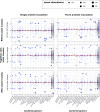Identity and timing of protist inoculation affect plant performance largely irrespective of changes in the rhizosphere microbial community
- PMID: 40162835
- PMCID: PMC12016509
- DOI: 10.1128/aem.00240-25
Identity and timing of protist inoculation affect plant performance largely irrespective of changes in the rhizosphere microbial community
Abstract
Bacterivorous soil protists can have positive impacts on plant performance, making them attractive targets for novel strategies to improve crop production. However, we generally lack the knowledge required to make informed choices regarding the protist species to be used or the optimal conditions for such amendments. Here, we examined how identity, diversity, and timing of inoculation of well-described protists impacted plant development and rhizosphere microbiome assembly. We first studied the impact of individual inoculation of six well-characterized protists on lettuce growth, with Cercomonas sp. S24D2 emerging as the strain with the largest impact on plant growth. In a second step, we created a three-protist species mixture inoculant by adding two protist species (Acanthamoeba sp. C13D2 and a heterolobosean isolate S18D10), based on differences in their feeding patterns. We then inoculated Cercomonas sp. either individually or in the protist mixture to lettuce plants 1 week before, simultaneously with, or 1 week after seedling transfer. We monitored plant growth and nutrient content, as well as impacts on the resident soil and rhizosphere microbiome composition. We found that early protist inoculation provided the greatest increase in aboveground biomass compared to the non-inoculated control. Single- and mixed-species inoculations had similar impacts on plant development and only minor impacts on prokaryotic community composition. While early inoculation seems to be the most promising timing for eliciting the positive effects of protist amendments, further, more systematic studies will be necessary to determine the conditions and ecological interactions that yield consistent and predictable improvements in plant performance.
Importance: The application of microorganisms, including bacterivorous soil protists, has been increasingly suggested as a sustainable agricultural approach. While positive impacts of the presence of predatory protists have been generally reported, the effects of the selected species and amendment conditions are largely unknown. Here, we examined how identity, diversity, and timing of inoculation of well-described protists impacted plant development and rhizosphere microbiome assembly. One species emerged as the one having the strongest impact in our specific system. This result highlights the importance of species selection for optimal outcome, but also suggests a huge potential in the barely investigated protist diversity for targeted application. Furthermore, the application of the inoculants before plant transfer showed the strongest effects on plants, providing some useful and new insights on the optimal time for such amendments.
Keywords: bacteria; inoculation time; lettuce; protozoa; soil.
Conflict of interest statement
The authors declare no conflict of interest.
Figures




Similar articles
-
Predatory protists impact plant performance by promoting plant growth-promoting rhizobacterial consortia.ISME J. 2024 Jan 8;18(1):wrae180. doi: 10.1093/ismejo/wrae180. ISME J. 2024. PMID: 39312488 Free PMC article.
-
Rhizosphere-colonizing bacteria persist in the protist microbiome.mSphere. 2025 May 27;10(5):e0003725. doi: 10.1128/msphere.00037-25. Epub 2025 Apr 30. mSphere. 2025. PMID: 40304530 Free PMC article.
-
Succession of the Resident Soil Microbial Community in Response to Periodic Inoculations.Appl Environ Microbiol. 2021 Apr 13;87(9):e00046-21. doi: 10.1128/AEM.00046-21. Print 2021 Apr 13. Appl Environ Microbiol. 2021. PMID: 33637572 Free PMC article.
-
Protists: Puppet Masters of the Rhizosphere Microbiome.Trends Plant Sci. 2019 Feb;24(2):165-176. doi: 10.1016/j.tplants.2018.10.011. Epub 2018 Nov 13. Trends Plant Sci. 2019. PMID: 30446306 Review.
-
Emerging Pathways for Engineering the Rhizosphere Microbiome for Optimal Plant Health.J Agric Food Chem. 2023 Mar 22;71(11):4441-4449. doi: 10.1021/acs.jafc.2c08758. Epub 2023 Mar 8. J Agric Food Chem. 2023. PMID: 36890647 Review.
References
-
- Singer D, Seppey CVW, Lentendu G, Dunthorn M, Bass D, Belbahri L, Blandenier Q, Debroas D, de Groot GA, de Vargas C, Domaizon I, Duckert C, Izaguirre I, Koenig I, Mataloni G, Schiaffino MR, Mitchell EAD, Geisen S, Lara E. 2021. Protist taxonomic and functional diversity in soil, freshwater and marine ecosystems. Environ Int 146:106262. doi:10.1016/j.envint.2020.106262 - DOI - PubMed
-
- Clarholm M. 1985. Possible roles for roots, bacteria, protozoa and fungi in supplying nitrogen to plants
-
- Ekelund F, Saj S, Vestergård M, Bertaux J, Mikola J. 2009. The “soil microbial loop” is not always needed to explain protozoan stimulation of plants. Soil Biology and Biochemistry 41:2336–2342. doi:10.1016/j.soilbio.2009.08.019 - DOI
MeSH terms
Grants and funding
LinkOut - more resources
Full Text Sources

